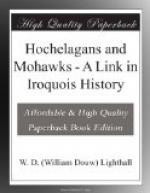Charlevoix, Histoire de la Nouvelle France, end of Bk. V., after describing the first mass at Ville Marie, in 1642, says: “The evening of the same day M. de Maisonneuve desired to visit the Mountain which gave the island its name, and two old Indians who accompanied him thither, having led him to the top, told him they were of the tribe who had formerly inhabited this country.” “We were,” they added, “very numerous and all the hills (collines) which you see to the south and east, were peopled. The Hurons drove thence our ancestors, of whom a part took refuge among the Abenakis, others withdrew into the Iroquois cantons, a few remained with our conquerors.” They promised Maisonneuve to do all they could to bring back their people, “but apparently could not succeed in reassembling the fragments of this dispersed tribe, which doubtless is that of the Iroquois of which I have spoken in my Journal.”
A proof that this people of Iroquet were not originally Algonquins is that by their own testimony they had cultivated the ground, one of them actually took up a handful of the soil and called attention to its goodness; and they also directly connected themselves in a positive manner with the Hochelagans by the dates and circumstances indicated in their remarks as above interpreted. The use of the term “Algonquin” concerning them is very ambiguous and as they were merged among Algonquin tribes they were no doubt accustomed to use that language. Their Huron-Iroquois name, the fact that they were put forward to interpret to the Iroquois in Champlain’s first excursion; and that a portion of them had joined the Iroquois, another portion the Hurons, and the rest remained a little band by themselves, seem to add convincingly to the proof that they were not true Algonquins. Their two names “Onontchataronons” and “Iroquet” are Iroquois. The ending “Onons” (Onwe) means “men” and is not properly part of the name. Charlevoix thought them Hurons, from their name. They were a very small band and, while mentioned several times in the Jesuit Relations, had disappeared by the end of the seventeenth century from active history. It was doubtless impossible for a remnant so placed to maintain themselves against the great Iroquois war parties.




